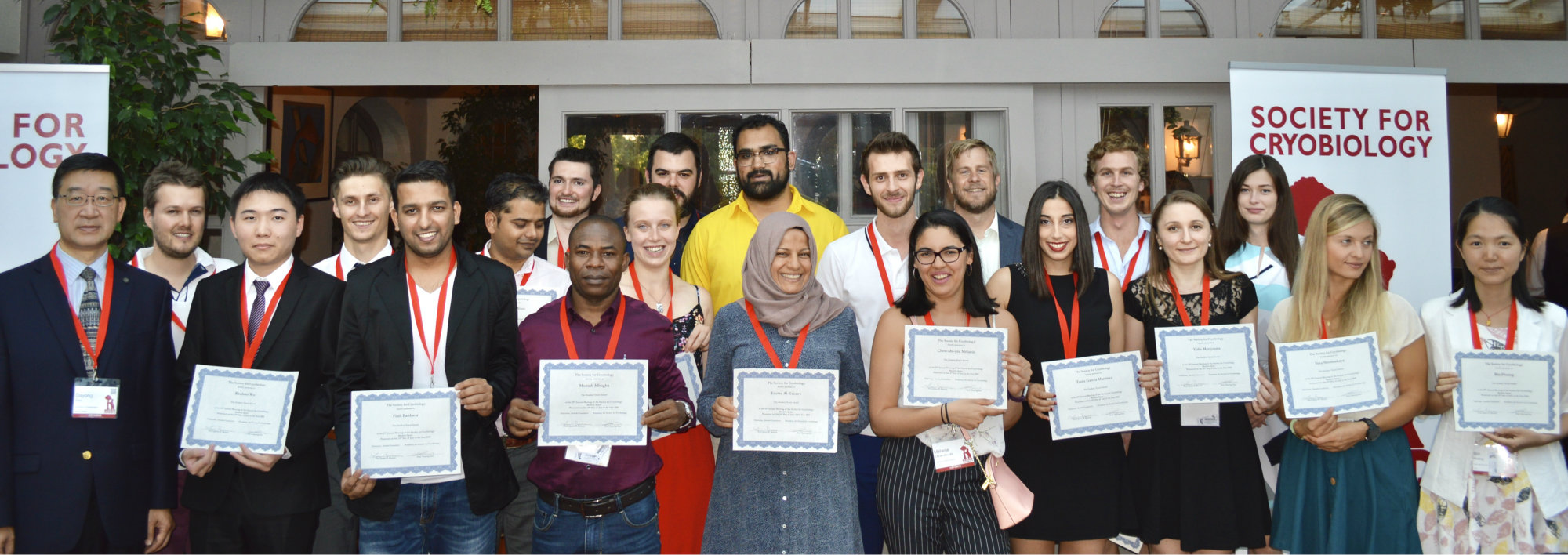Student Awards and Grants

Each year the Society for Cryobiology awards approximately $20,000 in travel grants to student members from around the world enabling them to travel to the meeting to present their research. A further $3,000+ in prize money is awarded to the winners of our competitive prizes, the Peter L. Steponkus Crystal Award, John K. Critser Award, and the winner of the Poster competition.
The purposes of the Student Awards Program are to promote the participation of student in scientific research and dissemination of such knowledge in cryobiology, and to improve scientific exchange and communication for young international cryobiology researchers. This aids in achieving one of our primary objectives: "to improve scientific understanding in cryobiology, and to disseminate and apply this knowledge for the benefit of mankind.”
Peter L. Steponkus Crystal Award Competition
The top four applicants, as selected by the Student Awards Committee, will present their work in a special session during the meeting. The winner of the Peter L. Steponkus Crystal Award receives an honorarium of $1,500.
John K. Critser Student Travel Award
The Critser Award offers a variable amount, based on need, to support meeting travel and expenses, awarded to the top ranked student extended abstract. This award is generously endowed by the Critser Family.
Student Poster Competition
All student posters are eligible to enter the student poster competition. The winner receives an honorarium of $500.
Student Travel Grants
Exact award amounts will depend on your geographic location and are at the discretion of the Student Awards Committee. Grants may be used for registration, travel, or accommodation. Grants usually range between $300 – $1,000.
Entry Criteria
To enter the student awards you must be a current student member of the Society for Cryobiology. Student membership is free with supporting evidence of full time student status.
How to Apply
Details on how to apply are on the annual meeting website. The next annual meeting will be https://cryo2026.com
Peter L. Steponkus Crystal Award Winners
2025 Charles Elder, University of Louisville, USA
Catechins Reduce Membrane Fragility to Enhance Red Blood Cell Stability during Lyophilization
2024 Linnea Warburton, UC Berkeley, USA
Cryopreservation of 3D Bioprinted Scaffolds with Temperature-Controlled-Cryoprinting
2023 Iqra Azam, University of Saskatchewan, Canada
Multiscale Transport and 4D Time-Lapse Imaging in Precision Cut Liver Slices
2022 Logan Brown, University of New Hampshire, USA
Structural and Functional Characterization of Antifreeze Protein APAFP752
2021 Shen Ren, University of Washington, USA
Successful Vitreous Cryopreservation of Rabbit Jugular Vein using Magnetic Nanoparticles Enhanced Single_Mode Electromagnetic Resonannce Rewarming System
2020 Purva Joshi, Carnegie Mellon University, USA
Thermal Analysis of Nanowarming in a Human Heart and a Rat Heart Model
2019 Kanav Khosla, University of Minnesota, USA
Successful Cryopreservation of Zebrafish Embryos follows by Hatching and Spawning with Laser Gold Nanowarming
2018 Zoran Marinovic, Szent István University, Hungary
Testis Cryopreservation and Spermatogonia Transplantation as a Tool for Zebrafish Line Reconstitution
2017 Jiaji Pan, University of Washington, USA
Optimization of EM resonance rewarming for cryopreservation of large biomaterial: hybrid EM-conduction rewarming and embdedded nanoparticle enhancement
2016 Miao Zhang, Leibniz University Hannover, Hannover, Germany
Combining endocytic and freezing-induced trehalose uptake for cryopreservation of mammalian cells
2015 Jennie Briard, University of Ottawa, Canada
Carbohydrate-Based Small Molecule Ice Recrystallization Inhibitors as Cryopreservatives for Red Blood Cells
2014 Daisuke Takahashi, Iwate University, Morioka, Japan
Compositional and Functional Analyses of Glyco-sylphosphatidylinositol-anchored Protein (GPIAP) During Plant Cold Acclimation
2013 Justin S. Feig, Carnegie Mellon University, Pittsburgh, PA, USA
Integration of polarized light into scanning cryomacroscopy
2012 Ruqayyah Almizraq, University of Alberta, Canada
The effects of biochemical rejuvenation on red blood cell microvesiculation, phosphatidylserine and CD47 expression during hypothermic storage
2011 Allyson K. Fry, Oregon State University, USA
Rational design of toxicity minimized cryoprotectant addition and removal procedures for vitrification of adherent cell monolayers
2010 Ida Risenga, University of the Witwatersrand, South Africa
Does cryo-preparative drying cause apoptotic-like programmed cell death or necrosis in isolated eucalyptus grandis axillary buds?
2009 Alireza Abazari, University of Alberta, Canada
Modeling transport phenomena in cartilage
2008 First Equal Jelena L. Holovati, University of Alberta, Canada
Liposomes improve recovery and minimize membrane injury of frozen red blood cells
2008 First Equal James D. Benson, University of Missouri-Columbia, USA
A coupled concentration and fluid transport model for cells, tissues and their boundary layers
2007 Andrew D. Weiss, University of Alberta, Canada
Contributions of individual cryoprotective agents to the glass stability of solutions
2006 Shannon L. Stott, Georgia Institute of Technology, USA
Cell perimeter modulates the kinetics of intracellular ice formation and frequency of paracellular ice formation in micropatterned endothelial cells
2005 Ansgar Petersen, Helmholtz Institute Aachen, Germany
Ice nucleus formation on demand and its benefits for freeze applications
2004 Julia Kopeika, University of Luton, UK
Cryoinjury to the genome. Any consequences?
2003 Kristi K. Snyder, State University of New York-Binghamton, USA
Cardiomyocyte responses to thermal excursions: implications for electrophysiological cardiac mapping
2002 Phillip H. Purdy, Colorado State University, USA
Flow cytometric assessment of fluctuations in the membrane fluidity and viability of chinese hamster ovary (CHO) and bull sperm cells using the fluorescent stains TMAP-DPH and propidium iodide
2001 Nancy Ekdawi-Sever, University of Wisconsin-Madison, USA
Optimization of the freeze-drying protocol for maximum cell recovery
2000 Abira Pyne, University of Minnesota, USA
Crystallization of mannitol below the glass transition temperature in binary and ternary systems during freeze-drying
1999 John M. Baust, State University of New York-Binghamton, USA
Identification and quantification of cryopreservation induced apoptosis
1998 Ramachandra Devireddy, University of Minnesota, USA
Water Permeability Parameters of Mouse Sperm during Freezing in the Presence of Extracellular Ice and Glycerol
1997 Ralph Speetzen, Helmholtz Institute Aachen, Germany
MRI-controlled minimally invasive interstitial cryotherapy of the liver by percutaneous access
1996 Jiang Zhang, Cornell University, USA
Proposed mechanism for depression of the liquid-crystalline-to-gel phase transition temperature of phospholipids in dehydrated sugar-phospholipid mixtures
1995 John A. Mugnano, Miami University, USA
Antifreeze glycoproteins promote lethal intracellular freezing of rat cardiomyocytes at high subzero temperatures
1994 Poula Reinhoud, Leiden University, The Netherlands
Vitrification of tobacco cells: cryoprotection by proline
1993 Jens O.M. Karlsson, Massachusetts Institute of Technology, USA
A model of crystal growth in cells during cryopreservation
1992 Carol A. Podlasek, University of Notre Dame, USA
A study of polyol metabolism in hyalophora cecropia by 19H and 13C NMR spectroscopy
Student Best Poster Competition Winners
2025
Best In Person Poster
Alba Lago, University of Vigo, Spain
Jellyfish on Ice: A New Frontier in Marine Cryobiology
2024
Best In Person Poster
Cameron Sugden, Oregon State University, USA
High Throughput Screening of Cryoprotective Agents for Vitrification Capabilities
Best Virtual Poster
Anna Kaverinska, Institute for Problems in Cryobiology and Cryomedicine, Ukraine
Freeze-Drying Preserves in Vitro Biological Effect of the Umbilical Cord Extract
2023
Best In Person Poster
Zonghu Han, University of Minnesota, USA
Model-Guided Design and Optimization of CPA Perfusion Protocols for Whole Organ Cryopreservation
Best Virtual Poster
Sarah Breedon, Carleton University, Canada
Sub-Zero MicroRNA Expression in the Liver of Frozen Chrysemys Pica Marginata
2022
Best In Person Poster
Yanan Gao, Warwick University UK
Evaluating L-Proline as a Cryoprotectant for 3 and 3-D Cell Models
Best Virtual Poster
Tighe Bloskie, Carleton University, Canada
Frozen Brain Epigenetics: Reduced H3K9 Methylation in Wood Frog Metabolic Recovery
2021 - Best Virtual Poster
Martin Daily, Leeds University, UK
A Biocompatible Ice Nucleating Agent Eliminates Supercooling and Enhances Cell Cryopreservation in 96-Well Plates
2020 - Best Virtual Poster
Hiroki Watanabe, Shinsgu University, Japan
Development of Automatic Thawing Apparatus for Cryoprotectant-Free Cryopreservation
2019 Kezhou Wu, University of Alberta, Canada
Surrounding Vitrification Solution is not required for Vitrification of Articular Cartilage
2018 Mélanie Chow-Shi-Yée, Université du Québec à Montréal, Canada
Protection against cell death during cryopreservation with wheat proteins: which mode of cell death?
2017 Kezhou Wu, University of Alberta, Canada
Optimization of additives to mitigate chondrocyte toxicity during exposure to cryoprotective agents
2016 Vanessa Musca, University of Ottawa, Canada
Importance of the C1 heteroatom in aryl glycoside ice recrystallization inhibitors
2015 Jaanika Edesi, University of Oulu, Finland
The Effect of Light Spectral Quality on Cryopreservation Success of Potato (Solanum Tuberosum L.) Shoot Tips
2014 Michal Zielinski, University of Alberta, Edmonton, Canada
Comparison of Non-ideal Solution Theories for Multi-solute Solutions in Cryobiology and Tabulation of Required Coefficients
2013 Ran Drori, The Hebrew University of Jerusalem, Israel
Kinetics of hyperactive and moderate antifreeze proteins
2012 Nadia Canorio Pariona, Univesidad Nacional Mayor de San Marcos, Peru
Cryocapacitation of Alpaca (Vicugna pacos) sperm cell
|


